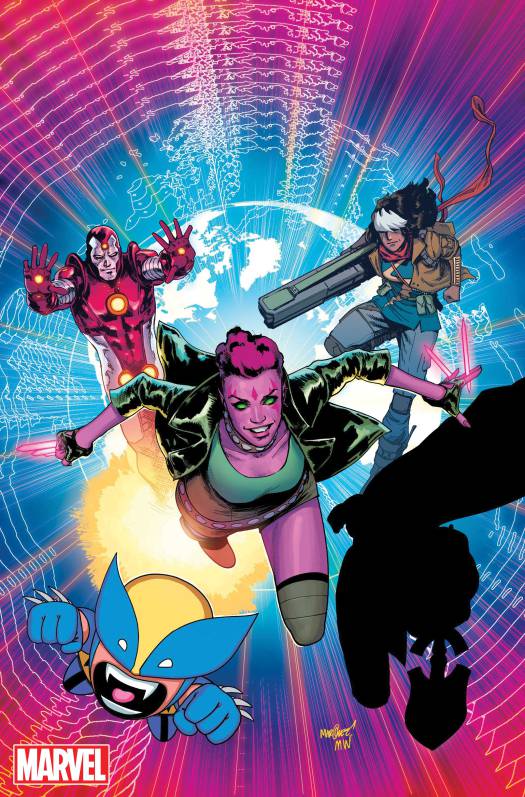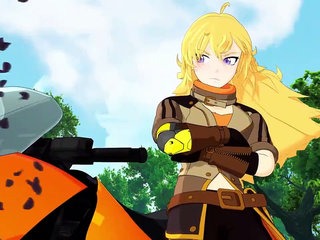The evening started with a quick hand of Love Letter between Blue and Burgundy while they waited for their “Fave” pizzas to arrive. The game only lasted a handful of turns and Blue took it with the Princess when she played a Baron to force a comparison. As Burgundy said, with that combination of cards lined up against him, his poor Baron didn’t stand a chance. There wasn’t time for him to get his revenge, however, as food arrived, along with a Happy Birthday text from Pink (who wasn’t able to come). With the arrival of Red and Magenta, Blue and Red talked about work for a few minutes before Ivory and Pine joined the party and everyone settled down to a quick game of 6 Nimmt!—a quick game that could be played while eating pizza.
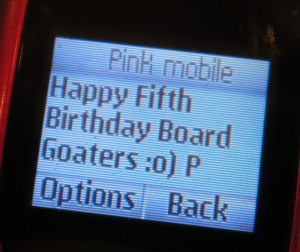 |
| – Image by boardGOATS |
Bizarrely, Ivory had somehow managed to avoid playing 6 Nimmt! despite it being one of our most frequently played games. So, there was a quick run-down of the rules before we could start. The game starts with four cards face up on the table, the beginning of four rows. Each player starts with a hand of cards and players simultaneously choose one and place it face-down before a simultaneous reveal. Cards are then played in ascending order, with players placing their card on the highest card that is lower than the card being played. When the sixth card is added to a row, the first five are taken by the active player and the number of heads contribute to that player’s score; lowest score wins. We tend to play two rounds, each using half of the deck of one-hundred and four cards. The thing that makes the game so compelling is that players begin to feel they have control over their destiny, but any grip they may have is incredibly tenuous and once things start to go wrong the problems tend to escalate horribly.
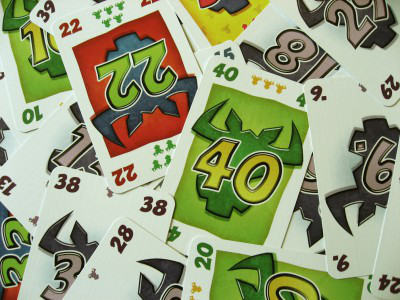 |
| – Image by boardGOATS |
This time, things started to go wrong early for Red and Blue, but Pine outstripped them by miles and finished the first round with twenty three “nimmts”—as he commented, enough for a whole dairy heard. Burgundy and Magenta were doing much better with one nimmt and none respectively. Given his excellent performance in the first round, everyone expected Burgundy to start collecting cards with enthusiasm in the second round, and so it proved. His efforts paled into insignificance compared with some of the others though, in particular Ivory and especially Blue, who finished with a massive top score of forty-four. The winner was unambiguously Magenta, however, who added a second clear round to her first and managed to end the game without picking up a single bull’s head, a real achievement.
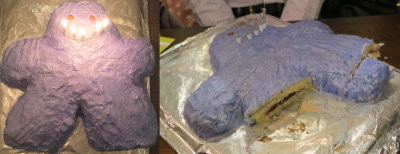 |
| – Image by boardGOATS |
With everyone now arrived and pizzas all consumed it was time for the party to really start, with the “Feature Game”, Crappy Birthday accompanied by a marvellous blue Meeple Cake supplied by Georgie from The Jockey. Everyone sang Happy Birthday and Blue and Green as the originators of the group blew out the candles then Red took the knife and started to carve while Magenta began dealing cards for the game. With everyone eating cake (including the people at the pub who couldn’t believe we’d been going for five years), attention turned to Crappy Birthday. This is funny little party game which we played for the first time last year to celebrate our fourth anniversary. The premise of the game is that it is one player’s birthday and every one gives them a “present” chosen from the cards in their hand. The birthday boy or girl then has to choose the best present and worst present and then returns these cards to the person who gave them. At the end of the game players count up the number of pressies they have had returned and the one with the most (i.e. the one who gave the fewest mediocre presents) is the winner. The game has a lot in common with Dixit, but is a lot simpler. In the same way though, the production quality of the cards is really key to making the game work, though the emotions are very different: in Dixit everyone marvels at the beauty of the art, in Crappy Birthday everyone laughs at the stupidity or brilliance of the gifts.
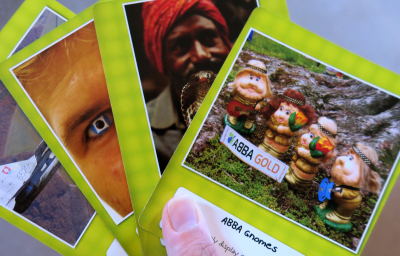 |
| – Image by boardGOATS |
This time we discovered that Black wanted a Viking helmet for his birthday, Red wanted to go on the first trip to Mars, Burgunday fancied a course in Sumo wrestling and a drive across the Sahara was on Ivory’s “Bucket List”. There were many amusing gifts that didn’t actually score points including the Gnome ABBA Tribute Band (singing, “Gnoming me, Gnoming you” perhaps?) and a dead rat to hang on the front door at New Year. We also discovered that Pine hates heights and horses (especially those that are trying to throw you off), so the session of rodeo riding was thrown straight back in disgust. Red returned a Porta-Potty (she’s seen plenty in the last year apparently); Blue threw back comedy lessons (she hates being on stage); Black sent back a chair because it was boring and Red decided she couldn’t cope with a 150lb burger and claimed it would make her sick. Everyone clearly thought that physical exertion was not Burgundy’s thing, but it was the tight rope walking that he was least keen on while Ivory had a fit of shyness and turned down the kind offer of a session skinny-dipping. Purple rejected the idea of her very own personal roller-coaster, though it was close between that and snake charming lessons. Pine commented that he would have combined the snake charming with the five chihuahua puppies as the latter would have provided an excellent food supply for the snakes. This did not go down well with Purple who had chosen the chihuahua’s as her favourite gift and didn’t want them eaten…
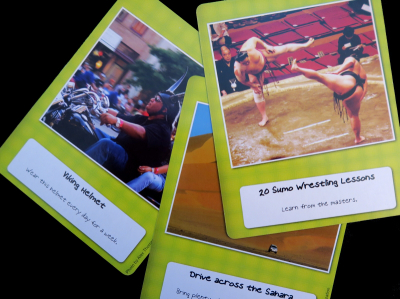 |
| – Image by boardGOATS |
It didn’t really matter who was the winner because everyone had fun and everyone got their moment in the spotlight as they had to explain their decisions. And while they listened everyone else got sticky eating the meeple cake which was soon nibbled away to leave just a bit of head and a foot. After one round we counted up who had the most returned cards and Ivory who had five cards was the winner by miles with Green and Burgundy in a distant, joint second place. Party games aren’t really the Group’s “thing”, but everyone enjoyed this one (particularly accompanied by cake) and the consensus seemed to be that once a year was about probably right, especially as it gave everyone time to forget the silly things on the cards. With the birthday cards collected in and the cake mostly gone it was time to decide what to play. Nobody was quick to decide and things were complicated by those planning to leave early. In the end we decided to stick together as a group (it was a party after all) and play a round of Saboteur.
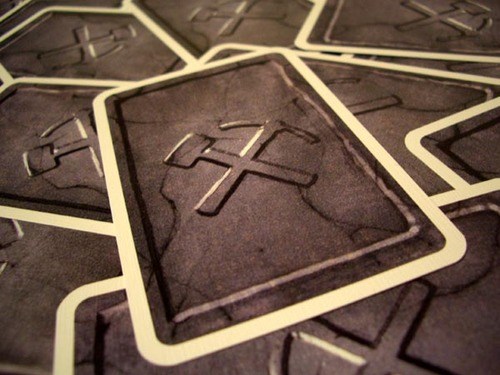 |
| – Image used with permission of BGG contributor mothertruckin |
The idea of Saboteur is that each player is either a Dwarf or a Saboteur and players take it in turns to play a card from their hand. The Dwarves aim is to extend the tunnel to the treasure, while the Saboteurs try to stop them. There are two types of cards that can be played: tunnels and special cards. The cards with tunnel fragments shown must be played in the correct orientation, though the tunnel depicted can include junctions, bends, and even dead-ends. While the Dwarves try to push the path towards the gold, Saboteurs try to play disruptive cards while trying not to look like it. Meanwhile, special cards include “rockfall” cards which can be played to remove a tunnel card already played, and maps which can be used to see where the gold is hidden. Most importantly, however are “broken tool” cards which can be played on another player to prevent them building tunnel cards until they (or another kind-hearted soul) plays a matching “fixed tool” card to remove it. The game is supposed to be played over several round with the winning team sharing out a pile of gold cards, but we tend to play it as a team game and stick to one round at a time.
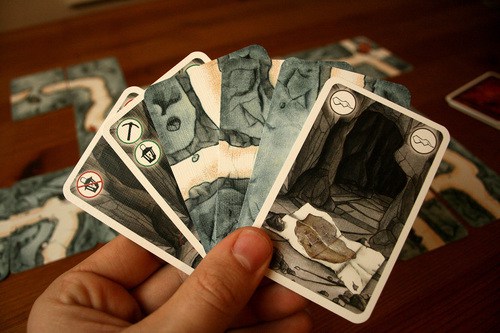 |
| – Image used with permission of BGG contributor mikehulsebus |
The game began quite carefully with everyone doing their best to look like dwarves, that didn’t stop the accusations though and it wasn’t long before someone decided that Black and Green were looking shifty. Green had almost all the map cards and unsportingly decided to stick to the rules and refused to share them. Then Pine roused suspicions when his use of a map card led to a disagreement with Green clearly identifying one of them as a Saboteur. Before long Ivory had joined the fray and nobody knew what was going on, except that the tunnels kept moving forward. Eventually, Blue left nobody in any doubt when she gleefully diverted the tunnel away from the only possible remaining gold. With the last card in the draw deck gone, it went down to the wire, but all the sabotage from Blue, Pine and Ivory was to no avail. Cards continued to be played and it took a whole extra round, but the Dwarves just managed to make it to the treasure.
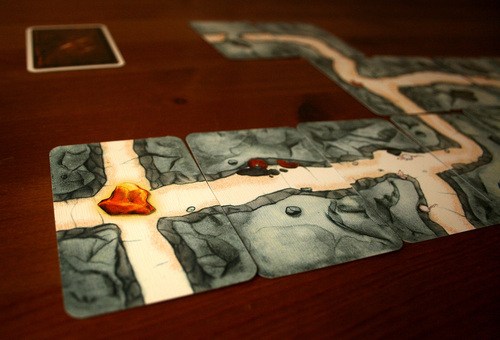 |
| – Image used with permission of BGG contributor mikehulsebus |
With time ticking on, Red and Magenta left for an early night and the residue of the group split into two parts, the first of which played Sheep & Thief. This game has had a couple of outings recently, in particular on a Tuesday two weeks ago. Sheep & Thief is a curious little tile/card drafting and laying game with elements of pick up and deliver mechanisms added for good measure. Each player has a board divided into a four by four grid, and starts with their home card and two sheep in the top left hand corner. Each round is played in two halves: first players draft cards then they play them, taking it turns to place one card per turn. Players are trying to connect their home card to the other three corners while trying to keep their sheep safe and trying to catch other players sheep with their fox, meanwhile, they are also attempting to navigate their black sheep to the bottom left right corner of their board. With points for all sorts of things including sheep captured, sheep retained, long rivers, connecting the home card to the other corners of the board as well as for moving their black sheep as far from home as possible, it is a veritable “point salad”, but one where it is actually very difficult to do well.
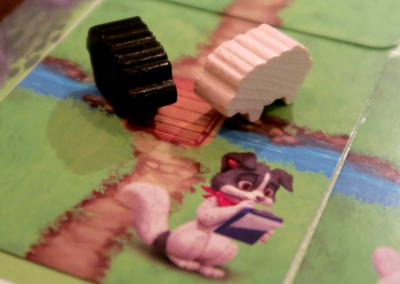 |
| – Image by boardGOATS |
Pine, with his love of sheep was always going to do do well, despite this being his first try at the game. Everyone else had played it several times before and therefore knew what they were letting themselves in for. The strategies were very varied though, for example, Purple prioritised getting her road from her home card to the opposite corner of her board and picked up fifteen points for doing so. Green prioritised getting his black sheep as far as he could in the hope that he might get points for his road in the process. Unfortunately, although Green’s sheep netted him fifteen points, he was not able to connect his home card to any other corner and therefore failed to get any extra points as a result. In contrast, Black tried to do a bit of everything which really isn’t a strategy that works for this game. As a result he really struggled. It was a very close game, and on the re-count finished in a tie between Green and Pine who both scored thirty-one points with Purple just behind. Since the tie-breaker is the number of sheep and and both Green and Pine finished with the same number of sheep the victory was shared.
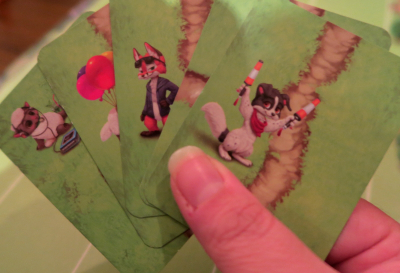 |
| – Image by boardGOATS |
On the next table, Ivory, Burgundy and Blue were being indecisive. In the end after looking longingly at the “Deluxified” Yokohama, they reluctantly decided that it would probably take too long and decided to give Dice Forge a go instead. This game was new to everyone except Ivory who gave his assurance that it would not be a long and complicated game. And he was right – the whole thing took less than an hour and a half including teaching. The game is a dice building game, with a lot in common with the deck building games like Dominion and bag building games like Orléans, or cup building games like Roll for the Galaxy, where the aim is to try to mitigate the effects of luck by stacking the deck, bag, cup or in this case dice, to improve the odds. In the case of Dice Forge, it is the dice themselves that players are modifying. Each player starts with two dice, similar to those in some of the Lego games, where the faces can be removed and changed.
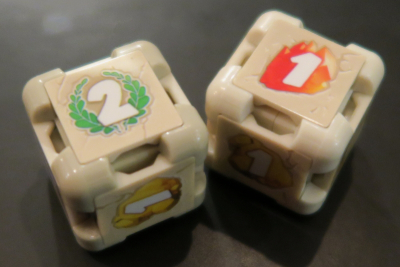 |
| – Image by boardGOATS |
Beyond this, the game is actually quite simple. On the active player’s turn, everyone rolls both their dice and adds the result to their accounting tracks. On their turn, the active play can then also spend some of their gains to either upgrade dice, or to move their pawn from their central “Starting Portals” to one of the “Islands” on the board and take a “Heroic Feat” card. Each upgrade has a cost, with the best upgrades having the highest costs. The cards also have costs and the most powerful cards are the most expensive. When upgrading, players can choose which faces to replace and what to replace them with. In contrast, most of the cards have a single use special action or bonus, but some also have a perpetual action. With the game restricted to only ten rounds, however, these have to be bought early if they are to prove game winners. Once everyone had had the full ten rounds, each player adds up their points and the player with the most is the winner
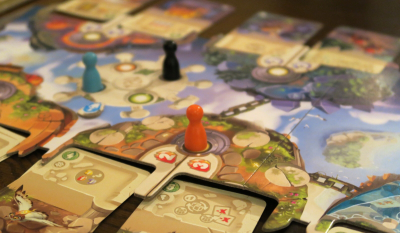 |
| – Image by boardGOATS |
There are several sources of points: firstly, some dice faces give points, but this is not a particularly efficient way of scoring unless there are some cards that can be used to increase the acquisition speed. Cards can be more effective, but only if the means to buy them can be accumulated quickly and efficiently. Blue started off trying to get some nice dice faces to improve the probability of a good roll. She quickly realised the really clever part of the game: what is the best way to upgrade the dice and how should the faces be distributed? For example, is it better to put all the good faces on one die and guarantee one good roll, or is it better to spread them across both and hope to roll more good rolls than bad ones? She opted for the latter, but wasn’t sure whether that was the right choice or not.
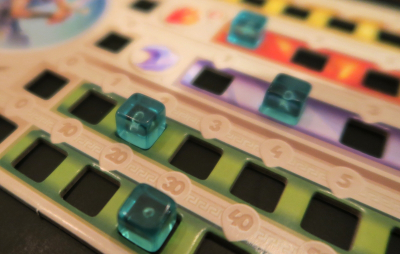 |
| – Image by boardGOATS |
While Blue was faffing about with where to put her dice, Burgundy had a much bigger problem as he was struggling to roll what he wanted in order to upgrade his. This had the knock-on consequence that by the time he got what he wanted, invariably, Blue or Ivory had pinched what he wanted. Ivory, having played the game before clearly had a much better idea of what he was trying to do, but although he managed some exceptional rolls, he struggled from time to time too. In the end, Burgundy more or less gave up on dice and started to collect cards. Somehow he managed to accrue a seventy-two cards—a massive number compared with compared with the forty-two/forty-six that Ivory and Blue had gathered together. It almost worked as well, since he netted a fantastic ninety-eight points, remarkable considering his very slow start. In the end Burgundy finished just two points behind Blue who top-scored with a nice round hundred. Everyone had enjoyed it though, despite the frustrations, and everyone was quite keen to give it another go, though not straight away as it was definitely home time.
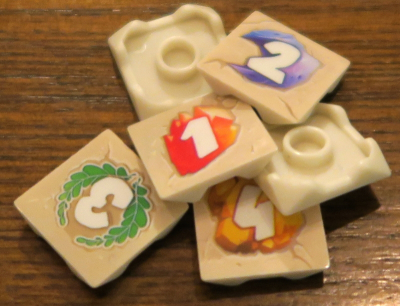 |
| – Image by boardGOATS |
Learning Outcome: Time flies when you are playing boardgames!
Share this:- More
